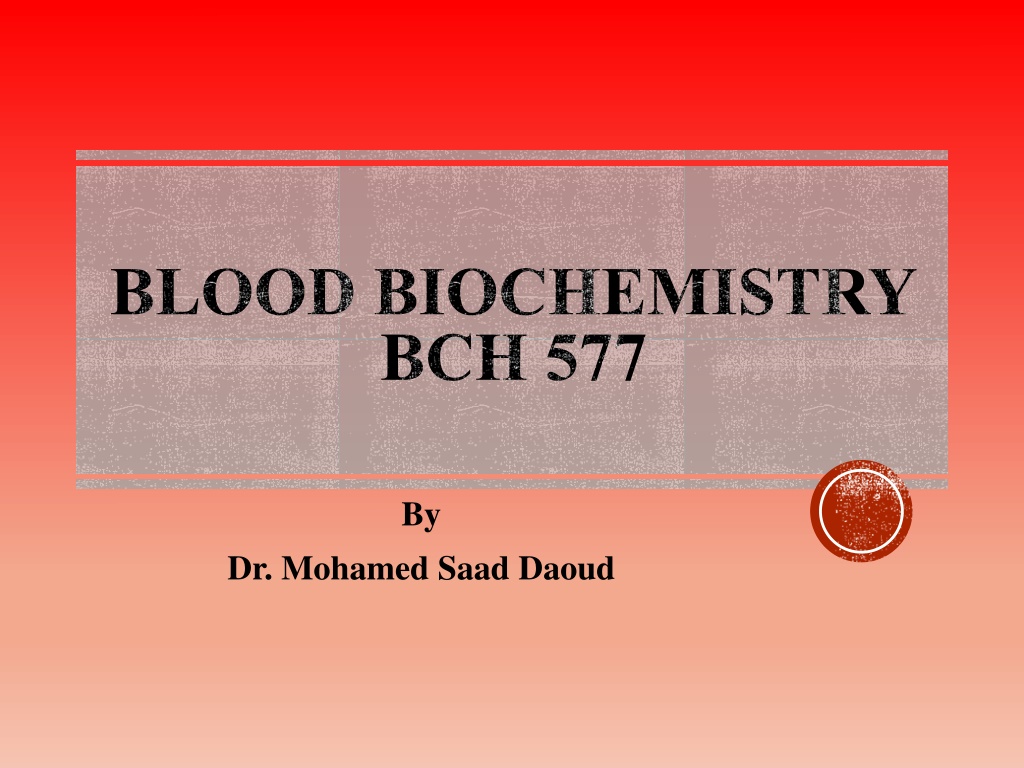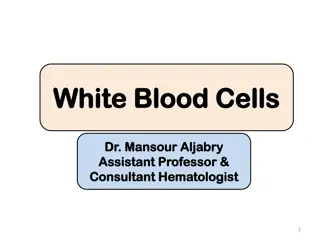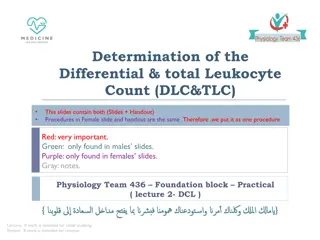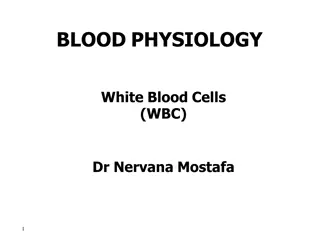Understanding White Blood Cells: Defense Mechanisms and Functions
White blood cells, specifically neutrophils and macrophages, play crucial roles in defending the body against infections. Neutrophils attack and destroy bacteria in the blood while macrophages, once matured in tissues, combat intratissue disease agents. These cells exhibit unique abilities such as diapedesis and ameboid motion to move through tissues and respond to chemotaxis, migrating towards inflamed areas due to various chemical substances. The process involves a complex interplay of cellular functions and immune responses.
Download Presentation

Please find below an Image/Link to download the presentation.
The content on the website is provided AS IS for your information and personal use only. It may not be sold, licensed, or shared on other websites without obtaining consent from the author. Download presentation by click this link. If you encounter any issues during the download, it is possible that the publisher has removed the file from their server.
E N D
Presentation Transcript
BLOOD BIOCHEMISTRY BCH 577 By Dr. Mohamed Saad Daoud
CELLS IN A NORMAL PERIPHERAL BLOOD SMEAR AND THEIR PHYSIOLOGICAL ROLES 2 Dr. Mohamed Saad Daoud
Neutrophils and Macrophages defend against infections The neutrophils and tissue macrophages attack and destroy invading bacteria, viruses, and other injurious agents. The neutrophils are mature cells that can attack and destroy bacteria even in the circulating blood. The tissue macrophages begin life as blood monocytes, which are immature cells while still in the blood and have little ability to fight infectious agents at that time. 3 Dr. Mohamed Saad Daoud
However, once immature macrophages enter the tissues, they begin to swell, sometimes increasing their diameters as much as fivefold, to as great as 60 to 80 micrometers. These cells are now called macrophages, and they are extremely capable of combating intratissue disease agents. 4 Dr. Mohamed Saad Daoud
White Blood Cells Enter the Tissue Spaces by Diapedesis Neutrophils and monocytes can squeeze through the pores of the blood capillaries by diapedesis. That is, even though a pore is much smaller than a cell, a small portion of the cell slides through the pore at a time. White Blood Cells Move Through Tissue Spaces by Ameboid Motion: Both neutrophils and macrophages can move through the tissues by ameboid motion. Some cells move at velocities as great as 40 mm/min. 5 Dr. Mohamed Saad Daoud
https://www.youtube.com/watch?v=2owNMyOO5_Q https://www.youtube.com/watch?v=R8VzquHdwZw&list=LLJnT x6S78GHvaLlAxFBbm3Q&index=2979 6 Dr. Mohamed Saad Daoud
White Blood Cells Are Attracted to Inflamed Tissue Areas by Chemotaxis. Many different chemical substances in the tissues cause both neutrophils and macrophages to move toward the source of the chemical (chemotaxis phenomenon). When a tissue becomes inflamed, at least a dozen different products are formed that can cause chemotaxis toward the inflamed area. 7 Dr. Mohamed Saad Daoud
(1) some of the bacterial or viral toxins (2) degenerative products of the inflamed tissues themselves. (3) several reaction products of the complement complex activated in inflamed tissues. (4) several reaction products caused by plasma clotting in the inflamed area. Chemotaxis depends on the concentration gradient of the chemotactic substance. The concentration is greatest near the source, which directs the unidirectional movement of the white cells. 8 Dr. Mohamed Saad Daoud
Chemotaxis is effective up to 100 micrometers away from an inflamed tissue. Therefore, because almost no tissue area is more than 50 micrometers away from a capillary. The chemotactic signal can easily move hordes of white cells from the capillaries into the inflamed area. Movement of neutrophils by diapedesis through capillary pores and by chemotaxis toward an area of tissue damage. 9 Dr. Mohamed Saad Daoud
https://www.youtube.com/watch?v=wTN7AP1WTUI 10 Dr. Mohamed Saad Daoud
https://www.youtube.com/watch?v=1SvEdg94qUA 11 Dr. Mohamed Saad Daoud
Phagocytosis The most important function of the neutrophils and macrophages is phagocytosis, which means cellular ingestion of the offending agent. Phagocytes must be selective of the material that is phagocytized; otherwise, normal cells and structures of the body might be ingested. 12 Dr. Mohamed Saad Daoud
How body cells protect themselves from Phagocytosis? First, most natural structures in the tissues have smooth surfaces, which resist phagocytosis. But if the surface is rough, the likelihood of phagocytosis is increased. Second, most natural substances of the body have protective protein coats that repel the phagocytes. Conversely, most dead tissues and foreign particles have no protective coats, which makes them subject to phagocytosis. Third, the immune system of the body develops antibodies against infectious agents such as bacteria. 13 Dr. Mohamed Saad Daoud
The antibodies adhere to the bacterial membranes and thereby make the bacteria especially susceptible to phagocytosis. To do this, the antibody molecule also combines with the C3 product of the complement cascade, which is an additional part of the immune system. The C3 molecules, in turn, attach to receptors on the phagocyte membrane, thus initiating phagocytosis. This selection and phagocytosis process is called opsonization. 14 Dr. Mohamed Saad Daoud
https://www.youtube.com/watch?v=LXno0vcW2Go 15 Dr. Mohamed Saad Daoud
Phagocytosis by Neutrophils The neutrophils entering the tissues are already mature cells that can immediately begin phagocytosis. On approaching a particle to be phagocytized, the neutrophil first attaches itself to the particle and then projects pseudopodia in all directions around the particle. The pseudopodia meet one another on the opposite side and fuse. This creates an enclosed chamber that contains the phagocytized particle. 16 Dr. Mohamed Saad Daoud
Then the chamber invaginates to the inside of the cytoplasmic cavity and breaks away from the outer cell membrane to form a free-floating phagocytic vesicle (also called a phagosome) inside the cytoplasm. A single neutrophil can usually phagocytize 3 to 20 bacteria before the neutrophil itself becomes inactivated and dies. 17 Dr. Mohamed Saad Daoud
Phagocytosis by Macrophages. Macrophages are the end stage product of monocytes that enter the tissues from the blood. When activated by the immune system they are much more powerful phagocytes than neutrophils, often capable of phagocytizing as many as 100 bacteria. They have the ability to engulf much larger particles, even whole red blood cells or, occasionally, malarial parasites, whereas neutrophils are not capable of phagocytizing particles much larger than bacteria. Also, after digesting particles, macrophages can extrude the residual products and often survive and function for many more months. 18 Dr. Mohamed Saad Daoud
Compare between phagocytosis by neutrophils and macrophages Once a foreign particle has been phagocytized, lysosomes and other cytoplasmic granules in the neutrophil or macrophage immediately come in contact with the phagocytic vesicle, and their membranes fuse, thereby dumping many digestive enzymes and bactericidal agents into the vesicle. 19 Dr. Mohamed Saad Daoud
Thus, the phagocytic vesicle now becomes a digestive vesicle, and digestion of the phagocytized particle begins immediately. Both neutrophils and macrophages contain an abundance of lysosomes filled with proteolytic enzymes for digesting bacteria and other foreign protein matter. The lysosomes of macrophages (but not of neutrophils) also contain large amounts of lipases, which digest the thick lipid membranes possessed by some bacteria (tuberculosis bacillus). 20 Dr. Mohamed Saad Daoud
https://www.youtube.com/watch?v=FZxf1QDcEO0 21 Dr. Mohamed Saad Daoud
In addition to the digestion of ingested bacteria in phagosomes, neutrophils and macrophages contain bactericidal agents that kill most bacteria even when the lysosomal enzymes fail to digest them because some bacteria have protective coats or other factors that prevent their destruction by digestive enzymes. Much of the killing effect results from several powerful oxidizing agents formed by enzymes in the membrane of the phagosome or by a special organelle called the peroxisome [large quantities of superoxide (O2 ), hydrogen peroxide (H2O2), and hydroxyl ions ( OH )] 22 Dr. Mohamed Saad Daoud
Also, one of the lysosomal enzymes, myeloperoxidase, catalyzes the reaction between H2O2 and chloride ions to form hypochlorite, which is exceedingly bactericidal. 23 Dr. Mohamed Saad Daoud
Monocyte-Macrophage Cell System (Reticuloendothelial System) Macrophages act as mobile cells that are capable of wandering through the tissues. However, after entering the tissues and becoming macrophages, another large portion of monocytes becomes attached to the tissues and remains attached for months or even years until they are called on to perform specific local protective functions. They have the same capabilities as the mobile macrophages to phagocytize large quantities of bacteria, viruses, necrotic tissue, or other foreign particles in the tissue. 24 Dr. Mohamed Saad Daoud
And, when appropriately stimulated, they can break away from their attachments and once again become mobile macrophages that respond to chemotaxis and all the other stimuli related to the inflammatory process. Thus, the body has a widespread monocyte-macrophage system in virtually all tissue areas. The total combination of monocytes, mobile macrophages, fixed tissue macrophages, and a few specialized endothelial cells in the bone marrow, spleen, and lymph nodes is called the reticuloendothelial system. However, all or almost all these cells originate from monocytic stem cells. The reticuloendothelial system is almost synonymous with the monocyte-macrophage system. 25 Dr. Mohamed Saad Daoud
Alveolar Macrophages in the Lungs Invading organisms frequently enter the body through the lungs. Large numbers of tissue macrophages are present as integral components of the alveolar walls. If the particle is digestible the macrophages digest them and release the digestive products into the lymph. If the particle is not digestible, the macrophages often form a giant cell capsule around the particle until such time if ever that it can be slowly dissolved. 26 Dr. Mohamed Saad Daoud
Inflammation: Role of Neutrophils and Macrophages Inflammation When tissue injury occurs by bacteria, trauma, chemicals, heat, or any other phenomenon, multiple substances are released by the injured tissues and cause secondary changes in the surrounding uninjured tissues. This entire complex of tissue changes is called inflammation. Inflammation is characterized by (1) vasodilation of the local blood vessels, with consequent excess local blood flow. (2) increased permeability of the capillaries, allowing leakage of large quantities of fluid into the interstitial spaces. 27 Dr. Mohamed Saad Daoud
(3) often clotting of the fluid in the interstitial spaces because of excessive amounts of fibrinogen and other proteins leaking from the capillaries. (4) migration of large numbers of granulocytes and monocytes into the tissue. (5) swelling of the tissue cells. Some of the many tissue products that cause these reactions are histamine, bradykinin, serotonin, prostaglandins. 28 Dr. Mohamed Saad Daoud
Different reaction products of the complement system, reaction products of the blood clotting system, and multiple substances called lymphokines are released by sensitized T cells (part of the immune system. These substances strongly activate the macrophage system, and within a few hours, the macrophages begin to devour the destroyed tissues. But at times, the macrophages also further injure the still-living tissue cells. 29 Dr. Mohamed Saad Daoud
Effect of Inflammation Walling-Off One of the first results of inflammation is to wall off the area of injury from the remaining tissues. The tissue spaces and the lymphatics in the inflamed area are blocked by fibrinogen clots so that after a while, fluid barely flows through the spaces. The walling-off process delays the spread of bacteria or toxic products. The intensity of the inflammatory process is usually proportional to the degree of tissue injury. Dr. Mohamed Saad Daoud 30
Macrophage and Neutrophil Responses During Inflammation Tissue Macrophage Is a First Line of Defense Against Infection. Within minutes after inflammation begins, the macrophages already present in the tissues, whether histiocytes in the subcutaneous tissues, alveolar macrophages in the lungs, microglia in the brain, or others, immediately begin their phagocytic actions. When activated by the products of infection and inflammation, the first effect is rapid enlargement of each of these cells. 31 Dr. Mohamed Saad Daoud
Next, many of the previously sessile macrophages break loose from their attachments and become mobile, forming the first line of defense against infection during the first hour or so. The numbers of these early mobilized macrophages often are not great, but they are lifesaving. 32 Dr. Mohamed Saad Daoud
Neutrophil Invasion of the Inflamed Area Is a Second Line of Defense. Within the first hour or so after inflammation begins, large numbers of neutrophils begin to invade the inflamed area from the blood. This is caused by products from the inflamed tissues that initiate the following reactions: (1) They alter the inside surface of the capillary endothelium, causing neutrophils to stick to the capillary walls in the inflamed area. This effect is called margination. 33 Dr. Mohamed Saad Daoud
(2) The intercellular attachments between the endothelial cells of the capillaries and small venules to loosen, allowing openings large enough for neutrophils to pass by diapedesis directly from the blood into the tissue spaces. (3) Other products of inflammation then cause chemotaxis of the neutrophils toward the injured tissues. Thus, within several hours after tissue damage begins, the area becomes well supplied with neutrophils Because the blood neutrophils are already mature cells, they are ready to immediately begin their scavenger functions for killing bacteria and removing foreign matter. 34 Dr. Mohamed Saad Daoud
Second Macrophage Invasion into the Inflamed Tissue Is a Third Line of Defense. Monocytes from the blood enter the inflamed tissue and enlarge to become macrophages. However, the number of monocytes in the circulating blood is low: also, the storage pool of monocytes in the bone marrow is much less than that of neutrophils. Therefore, the buildup of macrophages in the inflamed tissue area is much slower than that of neutrophils, requiring several days to become effective. 35 Dr. Mohamed Saad Daoud
Furthermore, even after invading the inflamed tissue, monocytes are still immature cells, requiring 8 hours or more to swell to much larger sizes and develop tremendous quantities of lysosomes; only then do they acquire the full capacity of tissue macrophages for phagocytosis. Yet, after several days to several weeks, the macrophages finally come to dominate the phagocytic cells of the inflamed area because of greatly increased bone marrow production of new monocytes. 36 Dr. Mohamed Saad Daoud
Macrophages can phagocytize far more bacteria (about five times as many) and far larger particles, including even neutrophils themselves and large quantities of necrotic tissue, than can neutrophils. Also, macrophages play an important role in initiating the development of antibodies. 37 Dr. Mohamed Saad Daoud
Increased Production of Granulocytes and Monocytes by the Bone Marrow Is a Fourth Line of Defense. Increased the production of both granulocytes and monocytes by the bone marrow. This results from the stimulation of the granulocytic and monocytic progenitor cells of the marrow. However, it takes 3 to 4 days before newly formed granulocytes and monocytes reach the stage of leaving the bone marrow. 38 Dr. Mohamed Saad Daoud
If the stimulus from the inflamed tissue continues, the bone marrow can continue to produce these cells in tremendous quantities for months and even years, sometimes at a rate of 20 to 50 times normal. 39 Dr. Mohamed Saad Daoud
Feedback Control of the Macrophage and Neutrophil Responses There are five factors play dominant roles in the control of the macrophage response to inflammation. These factors consist of: (1) tumor necrosis factor (TNF) (2) interleukin-1 (IL-1) (3) granulocyte-monocyte colony-stimulating factor (GM-CSF) (4) granulocyte colony-stimulating factor (G-CSF) (5) monocyte colony-stimulating factor (M-CSF). These factors are formed by activated macrophage cells in the inflamed tissues and in smaller quantities by other inflamed tissue cells. 40 Dr. Mohamed Saad Daoud
Control of bone marrow production of granulocytes and monocyte- macrophages in response to multiple growth factors released from activated macrophages in an inflamed tissue. G-CSF, granulocyte colony-stimulating factor; GM-CSF, granulocyte-monocyte colony-stimulating factor; IL-1, interleukin-1; M-CSF, monocyte colony-stimulating factor; TNF, tumor necrosis factor. 41 Dr. Mohamed Saad Daoud
The cause of the increased production of granulocytes and monocytes by the bone marrow is mainly the three colony- stimulating factors, one of which, GM-CSF, stimulates both granulocyte and monocyte production; the other two, G-CSF and M-CSF, stimulate granulocyte and monocyte production, respectively. This combination of TNF, IL-1, and colony-stimulating factors provides a powerful feedback mechanism that begins with tissue inflammation and proceeds to formation of large numbers of defensive white blood cells that help remove the cause of the inflammation. 42 Dr. Mohamed Saad Daoud
Acute Increase in Number of Neutrophils in the Blood Neutrophilia. Also within a few hours after the onset of acute, severe inflammation, the number of neutrophils in the blood sometimes increases fourfold to fivefold from a normal of 4000 to 5000 to 15,000 to 25,000 neutrophils per microliter. This is called neutrophilia, which means an increase in the number of neutrophils in the blood. Neutrophilia is caused by products of inflammation that enter the blood stream, are transported to the bone marrow, and there act on the stored neutrophils of the marrow to mobilize these into the circulating blood. This makes even more neutrophils available to the inflamed tissue area. Dr. Mohamed Saad Daoud 43
Formation of Pus When neutrophils and macrophages engulf large numbers of bacteria and necrotic tissue, essentially all the neutrophils and many, if not most, of the macrophages eventually die. After several days, a cavity is often excavated in the inflamed tissues that contain varying portions of necrotic tissue, dead neutrophils, dead macrophages, and tissue fluid. This mixture is commonly known as pus. 44 Dr. Mohamed Saad Daoud
After the infection has been suppressed, the dead cells and necrotic tissue in the pus gradually autolyze over a period of days, and the end products are eventually absorbed into the surrounding tissues and lymph until most of the evidence of tissue damage is gone. 45 Dr. Mohamed Saad Daoud
Eosinophils The eosinophils normally constitute about 2%. Eosinophils are weak phagocytes, and they exhibit chemotaxis. Eosinophils are often produced in large numbers in people with parasitic infections, and they migrate in large numbers into tissues diseased by parasites. Although most parasites are too large to be phagocytized by eosinophils or any other phagocytic cells. 46 Dr. Mohamed Saad Daoud
Eosinophils attach themselves to the parasites by way of special surface molecules and release substances that kill many of the parasites. 47 Dr. Mohamed Saad Daoud
For instance, one of the most widespread infections is schistosomiasis, the parasite can invade any part of the body. Eosinophils attach themselves to the juvenile forms of the parasite by: (1) releasing hydrolytic enzymes from their granules, which are modified lysosomes (2) releasing highly reactive forms of oxygen that are especially lethal to parasites. (3) releasing from the granules a highly larvacidal polypeptide called major basic protein. 48 Dr. Mohamed Saad Daoud
Eosinophils also have a special tendency to collect in tissues in which allergic reactions occur, such as in the per bronchial tissues of the lungs in people with asthma and in the skin after allergic skin reactions. This is caused by many mast cells and basophils participate in allergic reactions. Mast cell: A cell filled with basophil granules, found in numbers in connective tissue and releasing histamine and other substances during inflammatory and allergic reactions. 49 Dr. Mohamed Saad Daoud
The mast cells and basophils release an eosinophil chemotactic factor that causes eosinophils to migrate toward the inflamed allergic tissue. The eosinophils detoxify some of the inflammation-inducing substances released by the mast cells and basophils and probably also to phagocytize and destroy allergen-antibody complexes, thus preventing the excess spread of the local inflammatory process. 50 Dr. Mohamed Saad Daoud























